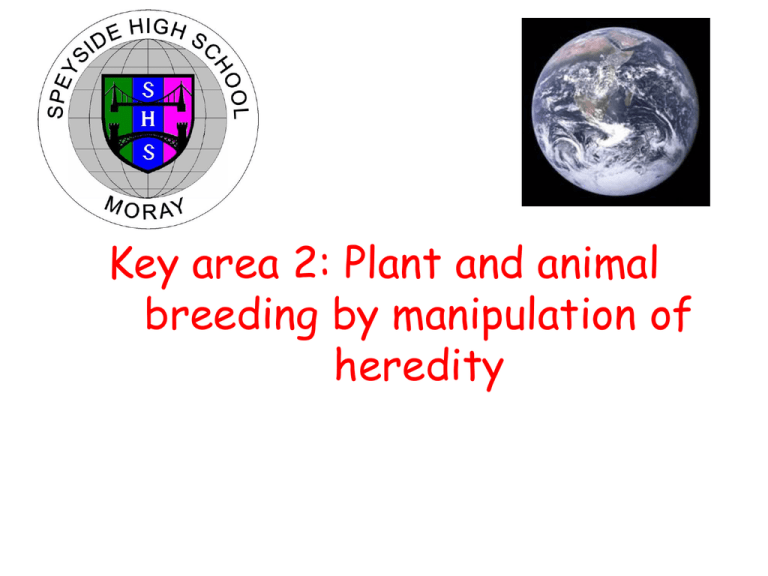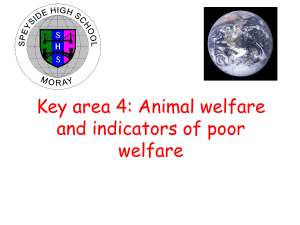Key area 2: Plant and animal breeding by manipulation of heredity
advertisement

Key area 2: Plant and animal breeding by manipulation of heredity Manipulating heredity LI: 1. Give examples of characteristics that have been selected for by breeders and explain their benefits. CFE Higher Biology Sustainability and interdependence Selective breeding Breeders of crops and livestock have been manipulating heredity (passing on of traits to offspring) for hundreds of thousands of years. CFE Higher Biology Sustainability and interdependence CFE Higher Biology Sustainability and interdependence Watch this clip on Supercows Selective breeding is done in order to produce new and improved cultivar of a plant or breed if an animal that will provide a sustainable source of food for humans. CFE Higher Biology Sustainability and interdependence Heritable characteristic Higher yield Example Increase in mass of food produced by wheat crop Higher nutritional Increase in mass of protein produced value by soya bean crop Resistance to pests Resistance of tomato to eelworm Resistance to disease Resistance of potato to late blight Possession of Growth of cereal crop to uniform useful physical height suited for mechanical characteristics harvesting Ability to thrive in Ability of maize to grow in cold, damp Sustainability a particular climate. CFE Higher Biology and environment interdependence Plant field trials LI: 1. Explain why plant field trials are carried out. 2. In plant field trials explain the importance of: selection of treatments, replicates and randomisation of treatments. CFE Higher Biology Sustainability and interdependence Plant field trials A plant field trial is a type of investigation, set up to: 1. Compare the performance of two different plant cultivars (e.g. conventional versus GM) under the same set of experimental conditions 2. Find out the effect of different environmental conditions on a new cultivar of crop plant. CFE Higher Biology Sustainability and interdependence Designing a plant field trial Once you have decided what it to be investigated the following factors must be considered: 1. Selection of treatments to be used 2. Number of replicates to be included 3. Randomisation of treatments CFE Higher Biology Sustainability and interdependence Assume we are conducting a field trial to investigate the effect of the concentration of nitrogenous fertiliser on a new cultivar of cereal plant. CFE Higher Biology Sustainability and interdependence 1. Selection of treatments For each equal sized crop only one variable should be altered e.g. concentration of fertiliser. All other variables should remain constant to ensure a valid comparison can be made (fair comparison). CFE Higher Biology Sustainability and interdependence 2. Number of replicates If only one treatment of each condition of fertiliser were carried out the results would be unreliable. Differences in each plot and differences in how the experiment was carried out would occur – this is called experimental error. CFE Higher Biology Sustainability and interdependence To minimise experimental error then a minimum of three replicates must be set up. The more replicates are set up the more reliable the results. CFE Higher Biology Sustainability and interdependence 3. Randomisation of treatments If the plots in a field were treated in an orderly basis then bias could exist. e.g. In this field there are 4 treatments (a, b, c and d) being investigated being repeated 3 times. Plot Block A B C 1 2 3 4 a b c d a b c d a b c d Non-randomised field trial CFE Higher Biology Sustainability and interdependence This bias could be due to conditions in the soil. Allocating the plot treatments randomly helps to minimise this bias. Plot Block A B C 1 2 3 a d b c b a c d d b a c Randomised field trial CFE Higher Biology Sustainability and interdependence 4 Selecting and breeding LI: 1. State the difference between inbreeding and outbreeding 2. Describe the effects on inbreeding: elimination of heterozygotes and inbreeding depression CFE Higher Biology Sustainability and interdependence Outbreeding Outbreeding involves the fusion of two gametes from unrelated members of the same species. Wild animals and cross-pollinating plants are naturally outbreeding. CFE Higher Biology Sustainability and interdependence Inbreeding Inbreeding involves the fusion of two gametes from close relatives. Inbreeding is naturally occurring in some species of self-pollinating plants e.g. peas, wheat and rice. CFE Higher Biology Sustainability and interdependence Effects of inbreeding Inbreeding ensures that the members of each generation of a selectively bred strain receive alleles for the desired characteristic. But can also lead to: 1. Loss of heterozygosity 2. Inbreeding depression CFE Higher Biology Sustainability and interdependence The Vadoma tribe of Zimbabwe have Ectrodactyly (two toed feet). This mutation is more common due to inbreeding. CFE Higher Biology Sustainability and interdependence 1. Loss of heterozygosity Heterozgosity Aa (selfed) P F1 AA F2 AA AA AA AA F3 Aa AA Aa Aa aa 100% aa Aa AA Aa Aa aa aa aa aa aa 50% 25% 4AA 4AA 4AA 4AA 4AA AA AA 4aa 4AA AA AA 4aa 4aa 4aa 4aa 4aa 12.5% 2Aa 2Aa 2Aa 2Aa aa aa aa aa CFE Higher Biology Sustainability and interdependence Continuous inbreeding leads to a loss of heterozygosity and development of homozygosity. CFE Higher Biology Sustainability and interdependence 2. Inbreeding depression If a natural outbreeder is forced to inbred inbreeding depression can occur. Inbreeding depression in maize CFE Higher Biology Sustainability and interdependence This is due to the accumulation of homozygous recessive alleles which can be deleterious (harmful). This appears as a decline in vigour, size, fertility and yield of the plant or animal. CFE Higher Biology Sustainability and interdependence Cross breeding and F1 Hybrids LI: 1. State that cross breeding can be used to produce individuals with desired characteristics of both parents. 2. Explain how a new cross breed can be maintained. 3. Define hybrid vigour CFE Higher Biology Sustainability and interdependence Hybrids An F1 hybrid is an individual resulting from a cross between two genetically dissimilar parents. Breeders will cross members of one variety of a species that have a desired characteristic with members of another variety that have another desired characteristic in the attempt to produce a hybrid that has both desirable characteristics. CFE Higher Biology Sustainability and interdependence Crossbreeding Because of the problems associated with inbreeding. New alleles can be introduced into a plant or animal species by crossbreeding with a strain exhibited a different but desired genotype. CFE Higher Biology Sustainability and interdependence Savannah cats Watch this video introducing the savannah cat Produced by breeding a serval with a domestic cat CFE Higher Biology Sustainability and interdependence Wild Serval cat X Domestic cat F1 hybrid X Looks like serval, retains some wild character F2 hybrid Looks like serval, CFE Higher Biology milder temprement Domestic cat This type of breeding is called a Sustainability backandcross interdependence Hybrid vigour Hybridisation (mating) of two different inbred homozygous cultivars of plant species produces offspring who are uniformly heterozygous. Parents gametes F1 AABBccdd X All ABcd aabbCCDD All abCD AaBbCcDd CFE Higher Biology Sustainability and interdependence They also display increased: • Vigour • Yield • Fertility This is called hybrid vigour. Poorer recessive genes are masked by superior dominant ones. Parent 1 CFE Higher Biology F1 hybrid Parent 2 Sustainability and interdependence However, if F1 hybrids are allowed to interbreed with one another, the F2 generation can be too genetically diverse and many will lack the improved characteristics. CFE Higher Biology Sustainability and interdependence Inheritance LI: 1. Explain what is meant by “true breeding” 2. Work the inheritance of a gene using a Punnet square. 3. Explain when a test cross would be used and work out the genotypes produced. CFE Higher Biology Sustainability and interdependence Single gene inheritance Variation in a population can be defined as either: • Continuous (varying from extreme to another) e.g. • Discrete (divides members of a species on to two or more groups) e.g. CFE Higher Biology Sustainability and interdependence A characteristic that shows discrete variation is normally controlled by alleles of a single gene. The alleles can either have be dominant or recessive. Characteristic Plant height Dominant Trait Tall Recessive Trait Dwarf Pod shape Inflated Constricted Pod colour Seed shape Flower colour Green Round Purple Yellow Wrinkled White CFE Higher Biology Sustainability and interdependence White Mouse (bb) White Mouse (bb) Black Mouse (BB) Black Mouse (BB) Black Mouse (BB) X X White Mouse (bb) White Mouse (bb) Black Mouse (BB) Black Mouse (BB) X X Black Mouse (BB) White Mouse (bb) True Breeding CFE Higher Biology Sustainability and interdependence Black Mouse (BB) White Mouse (bb) X Black Mouse (Bb) Black Mouse (Bb) Single gene inheritance Black Mouse (BB) X Black Mouse (Bb) Black Mouse (Bb) White Mouse (bb) CFE Higher Biology 3 Black Mice Sustainability and interdependence : 1 white mouse Test cross What genotype could this brown mouse have? How can you tell if this Black mouse is BB or Bb? CFE Higher Biology Sustainability and interdependence Test cross A test cross is a cross between an organism whose genotype for a certain trait is unknown and an organism that is homozygous recessive for that trait. CFE Higher Biology Sustainability and interdependence Black Mouse (?) White Mouse (bb) Black Mouse (?) X X ½ Black Mouse All Black Mice b White Mouse (bb) b ½ White Mouse b b B Bb B b B B b B b B Bb B b b b b b b Sustainability The genotype of theCFE unknown The genotype of the unknown Higher Biology and mouse must have been BB mouse must have been Bb interdependence Genetic technology LI: 1. Explain how genetic technology can be used to improve cultivars or breeds for commercial gain. 2. Give examples of crops produced by genetic transformation, explain how they were created and give their potential benefits. CFE Higher Biology Sustainability and interdependence Genetic technology As well as enhancing cultivars and breeds through breeding strategies, plants and animals can be enhanced by use of genetic technologies: 1. Genetic sequencing (remember from Unit 1) 2. Genetic transformation (remember from Unit 2) CFE Higher Biology Sustainability and interdependence Genetic sequencing Genetic sequencing techniques can be used to identify organisms that possess particular alleles for a desired characteristic. This organism can then be selected for use in a breeding programme. CFE Higher Biology Sustainability and interdependence Genetic transformation Genetic transformation is the transfer of genetic information from one organism to another (think back to GM crops in Nat 5). This technique can be used to enhance a crop species which can then be used in a breeding programme. CFE Higher Biology Sustainability and interdependence Case study Using the internet and other available resources complete the following table. Description of Potential how the crop was benefits created Bt toxin for pest resistance Golden rice Glyphosateresistance for herbicide tolerance 1. What gene was inserted? 2. Where did it originally come from? 3. What does the protein made from this gene do? Biology CFE Higher 1. What are the economic benefits 2. Or the health benefits 3. Or the environmental benefits Sustainability (Note: it may be only and one benefit) interdependence







